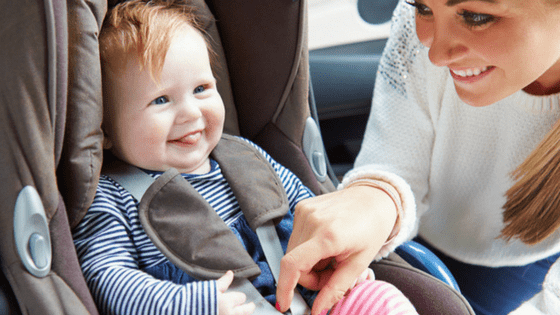Following the growth of your child may seem as though you’re following the growth of a pebble that will emerge into a wonderful diamond. As beautiful as the previous sentence sounds, this journey also starts with a few years’ worth of chasing down perhaps the most hyperactive being that is powered by a thousand batteries. Kidding aside, taking care of a toddler during their “learning” phase can be a fun and tiring journey for moms. However, part of this caring process is to make sure they’re exposed to the many things they can learn while keeping them safe. A big responsibility in this journey is to make sure toddlers are protected from motorcycle or car accidents.
Should there be instances where you have to take a toddler out for a walk to explore nature, chances are you may encounter a few roads. This is especially true if you’re teaching your toddler about basic traffic rules, such as which colors correspond to stop and go, when you can walk, when you have to stand, and where you can cross the road. However, accidents can happen anytime, and it’s important to be extra wary of what to do to keep you and your toddler safe.
According to the Centers for Disease Control and Prevention, around 150 patients that are 19 and below are actually in emergency departments every hour for injuries caused by vehicle crashes. Unfortunately, people aged 5 to 19 are also most likely to die due to injuries related to vehicle accidents than other forms of injuries. However, this doesn’t mean that parents don’t have the means to protect their children from these accidents.
Choose: A Seat For Every Age
When image of children and cars come up, there might be instances where you can see toddlers and children in different assortments of seats in different parts of the car. These aren’t fashion statements or choices by parents, but are in fact seats that are built specifically for that child’s age and build. These seats aren’t custom made, but are rather specially made for children. As such, children can actually be tucked in in car seats, booster seats, or seat belts depending on what’s recommended for them.
- Children aged 0 to 2 years are recommended to be in rear facing car seats located inside the back seat. These grant infants and younger toddlers the best protection possible from crashes until they reach the higher height and weight limits of these seats.
- Children aged 2 to 5 years can then proceed to use a a car seat facing forward inside the back seat. These seats are specially tailored to make sure they are tucked in their own safe space appropriately but at the same time remain tightly secure in the car. Again, use this until they outgrow their seats.
- Children ages 5 up can use booster seats until seat belts fit them. These children can be trained to use seat belts courtesy of a belt positioning booster seat. You know you’re using them correctly if you’re able to fit the seat belts when the belt along the lap is just on the upper thighs, and the belt on the shoulder goes over their chest. Try to reposition your child if the two belts go over the stomach and neck, respectively.
- Children ages 5 up that can use seat belts comfortably should start using them, especially if they outgrow their booster seats. Remember, you’d know seat belts are appropriate for your child if the lap belt is just across their upper thighs, and if the shoulder belt is across their chest. Anywhere close to the neck or to the stomach means you should probably still use booster seats.
While the ideas of getting more seats can be expensive, it can appear to be a worthy investment as it’s just one of many things that is in line are your children’s safety, and their future.
Choose: A Position For Every Age
Aside from what kind of seats your children should wear, you should also be wary where you’re positioning your children and what other assortments they can bring with them. This is because the fragility of a child’s body means extra care should be observed when positioning them inside the vehicle. For instance:
- Children under 12 should remain in the back seat regardless if they can wear seat belts or not. The recommended place is in fact in the middle of the back seat, as this is considered the safest position in the entire car.
- Likewise, don’t position children in front of an airbag, and as such children shouldn’t be in the front seat as airbags can be fatal for children in accidents.
- If possible, have children wear helmets throughout the trip, and anytime they’re using other vehicles such as skates, scooters, skateboards, bicycles, and motorcycles.
- If you have a teenager who’s learning how to drive, try to impose limitations as to where they go and who they can take with them. This is especially related to risky conditions such as driving at night or having a lot of passengers. Additionally, don’t let it become a habit for a new driver to help transport their younger siblings. If you have a toddler, be sure that you (an experienced driver) is the only one driving them around.
A lot of these things do appear to be things that can be trained as habits, or as security measures that should always be practiced. Don’t treat them as hassling protocols you should follow for an eventuality that “may never happen,” as accidents don’t choose people, places, and times to hit anyone and be its victim.
Conclusion
If you feel as though taking care of a toddler and keeping them safe against motorcycle or car accidents can be overwhelming, then hopefully the above article can help change your mind. Keeping your toddler safe from these vehicles is just an extra precaution you have to take in order for them to get to know themselves and the world more without any risk of dangers. If you want to take your safety to the next level, you may click here to learn more about the legal implications of this subject.
 About The Author: Vicki Haskett
About The Author: Vicki Haskett
Vicki is a law writing enthusiast who’s had over 25 years of experience in her field. She enjoys sharing her experiences with those who want to learn more about the legal world. In her spare time she spends quality time with her family and friends.
 Kaboutjie SA Mommy Blogs by Lynne Huysamen
Kaboutjie SA Mommy Blogs by Lynne Huysamen







Thank you for your article! I found it really useful to read about where the seatbelt is positioned for a child who is old enough to graduate from a booster seat! A very handy tip as I have always wondered exactly when car seatbelts become safe for little ones to use.
The most difficult part of following these rules is getting a toddler into the car seat. This occasionally lead to a power struggle for my little one. We always have been stern with him, we tried the best ways to make it fun to be buckled up. He is now 4 years old and follows the rules, when we leaving he gets into his car seat and buckles himself up.
My boy will request very politely to sit in the passenger seat, which we have declined time and time again. With kids at such a young age, once you allow this sort of behaviour it will become demanded from them in future. I rather prevent than have a real problem to deal with in future.
Another thing that simply annoys me, is kids that sit in the back seats and stick out their hands from the back windows or even their heads. Parents need to ensure their kids are seated and not jumping around on the back seat whilst they drive. This causes a lot of distraction for the driver as well. When kids are buckled up, you can drive peacefully, rather than them jumping around and getting hurt. This may even lead to an accident taking place.
Thanks for this informative article.
I found the information about the car seats very helpful. We bought two sizes for JD. The one from birth to 13kg and then the seat from two years and up.
There are a few makes and models available and I know there is actually one seat available between the two that I currently have.
JD hasn’t given us much trouble getting into his first car seat although he does get wriggly and impatient if he has to sit in it for too long.
He has now outgrown that car seat and we’ll start using the bigger seat. I hope that we will not have too much trouble with the transition. With toddlers you never quite know what to expect and they are not very fond of change.
I’ll just have to make it fun somehow. Keep him occupied with an interesting toy or gadget when he is seated.
I remember learning about the different road signs and looking left, right and left again before crossing a street. I will teach my child these as soon as he is old enough to understand and acknowledge what I’m trying to teach him. Road safety is integral in educating children from a young age.
An accident can happen in an instant. It’s better to be prepared and equip yourselves and your little one’s with the knowledge and tools needed to ensure child safety at all times.
Thanks for your article. There are just so many car seats to choose from.. Yes they are expensive but also very,very important. I don’t leave home or any place without buckling up the kids. They know my car won’t start unless everyone is buckled up and in their correct positions. You can consider yourself to be the safest driver but the next person can be reckless. Take nothing for granted. Our kids are important an no amobut of money to compromise in a good car seat can take it’s place. The problem really now is is granny! She doesn’t like to buckle up! But same rules apply for her lol! Thanks for that helpful tip about positioning an older child in the middle back, oh and the helmets…. it’s funny but so true. I’m taking the helmerd to school this afternoon. Let’s see if I can get away with this one…